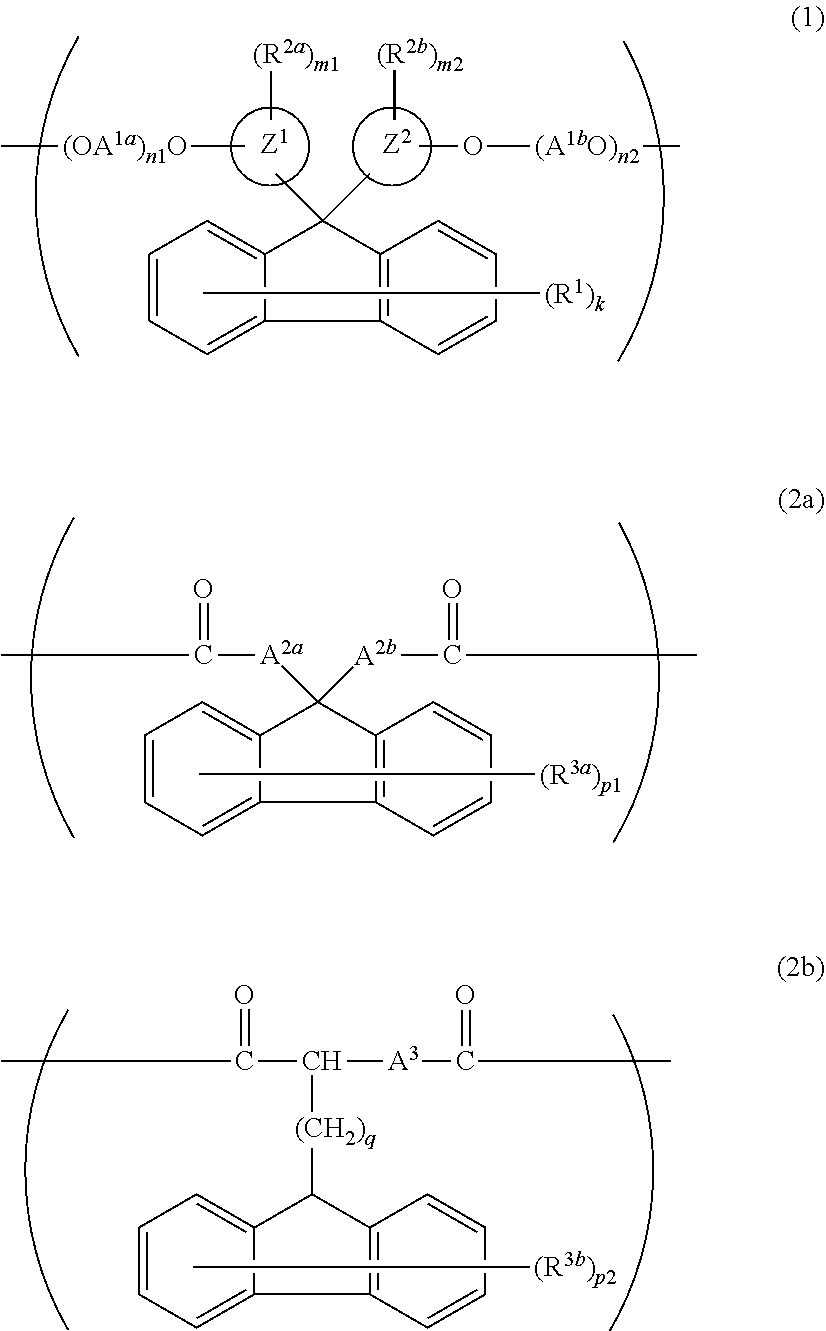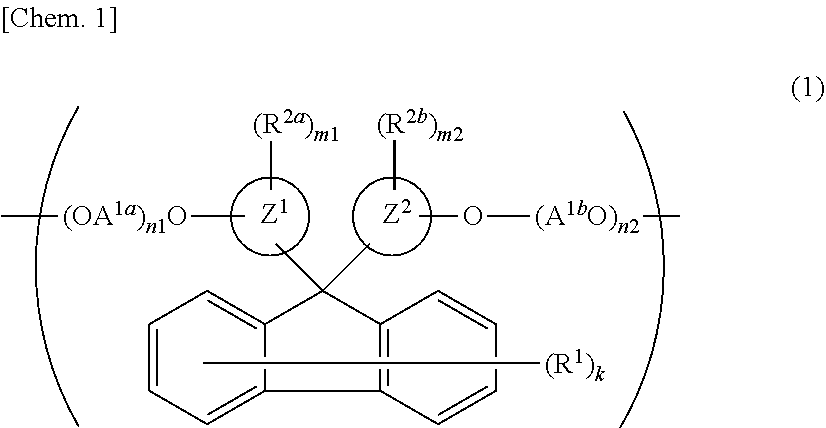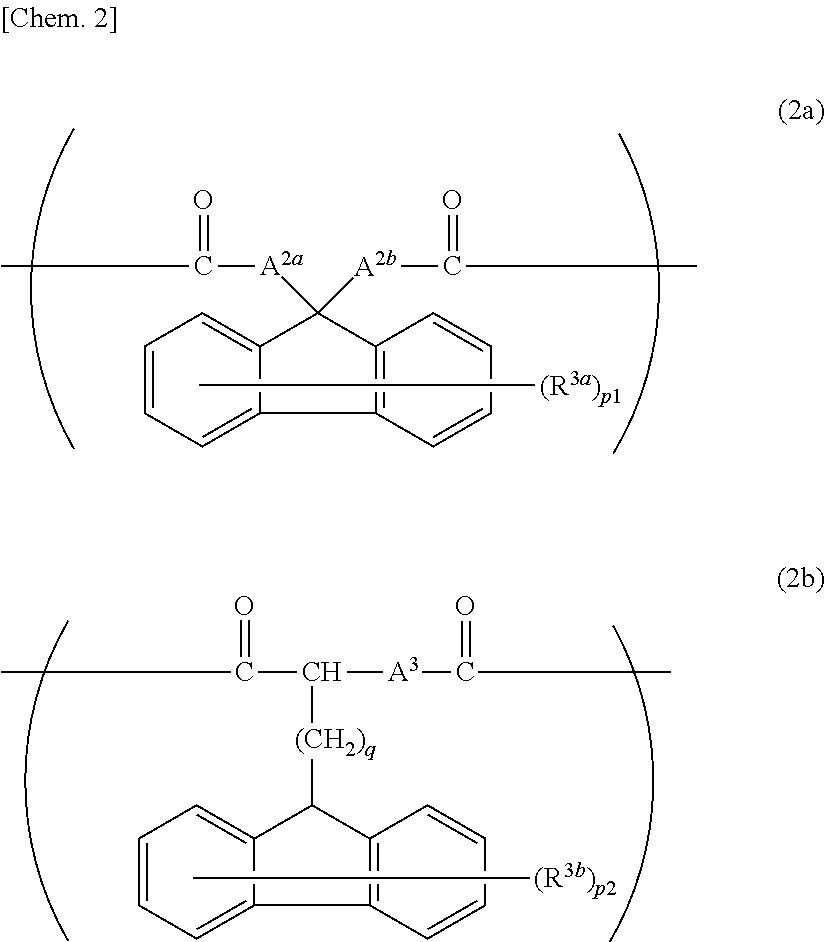Retardation film and method for producing the same
a technology of retardation film and film, which is applied in the field of retardation film, can solve the problem that the retardation film cannot be obtained easily, and achieve the effect of easy film breakage, excellent formability and handling, and high heat resistan
- Summary
- Abstract
- Description
- Claims
- Application Information
AI Technical Summary
Benefits of technology
Problems solved by technology
Method used
Image
Examples
synthesis example 1
[0202]To 1.00 mol of FDPM, 0.80 mol of BPEF, and 2.20 mol of EG were added 2×10−4 mol of manganese acetate tetrahydrate and 8×10−4 mol of calcium acetate monohydrate as transesterification catalysts, and the resulting mixture was gradually heat-melted while stirring. After the mixture was heated to 230° C., 14×10−4 mol of trimethyl phosphate and 20×10−4 mol of germanium oxide were added thereto. EG was removed from the resulting mixture while the mixture was gradually heated and depressurized to reach 270° C. and not more than 0.13 kPa. After reached a predetermined stirring torque, the content was removed from the reactor and was prepared to give a polyester resin 1 pellet.
[0203]A 1H-NMR analysis of the resulting pellet found that 100% by mol of the dicarboxylic acid component introduced to the polyester resin 1 was derived from FDPM, 80% by mol of the diol component introduced thereto was derived from BPEF, and 20% by mol of the diol component introduced thereto was derived from E...
examples 1 to 11
[0205]The polyester resin 1 produced in Synthesis Example 1 was melt-extruded at a temperature of 260° C. using a twin-screw extruder (“KZW15-30MG” manufactured by TECHNOVEL CORPORATION, L / D=45, screw diameter D: 15 mm, rotational speed: 200 rpm) to give an unstretched film having an average thickness of 50 μm, 80 μm, or 100 μm using T-die and winding apparatus. For each film obtained, the film was cut into a size of 60 mm×60 mm, and the cut film was uniaxially or biaxially stretched at the stretching method, the stretching temperature and the stretching ratio described in Table 1 and at a stretching speed of 120 mm / min. using a stretching apparatus (“Biaxial film stretcher IMC-1A97” manufactured by Imoto machinery Co., Ltd.) to give a stretched film. For Examples 10 and 11 subjected to biaxial stretching, the stretching was carried out at a stretching speed of 120 mm / min. in each direction. The R0(550), Rth(550), and average thickness of the resulting stretched films are shown in T...
examples 12 to 15
[0206]The polyester resin 1 produced in Synthesis Example 1 was melt-extruded at a temperature of 260° C. using a twin-screw extruder (“KZW15-30MG” manufactured by TECHNOVEL CORPORATION, L / D=45, screw diameter D: 15 mm, rotational speed: 200 rpm) to give an unstretched film having an average thickness of 125 μm, 100 μm, 80 μm, or 135 μm using T-die and winding apparatus. For each film obtained, the film was cut into a size of 60 mm×60 mm, and the cut film was uniaxially or biaxially stretched at the stretching method, the stretching temperature and the stretching ratio described in Table 1 and at a stretching speed of 120 mm / min. using a stretching apparatus (“Biaxial film stretcher IMC-1A97” manufactured by Imoto machinery Co., Ltd.) to give a stretched film. For Examples 14 and 15 subjected to sequential biaxial stretching, the stretching was carried out at the same stretching temperature (128° C.) and at the same stretching speed (120 mm / min.) in each direction. The R0(550), Rth(...
PUM
| Property | Measurement | Unit |
|---|---|---|
| wavelength | aaaaa | aaaaa |
| temperature | aaaaa | aaaaa |
| wavelength | aaaaa | aaaaa |
Abstract
Description
Claims
Application Information
 Login to View More
Login to View More - R&D
- Intellectual Property
- Life Sciences
- Materials
- Tech Scout
- Unparalleled Data Quality
- Higher Quality Content
- 60% Fewer Hallucinations
Browse by: Latest US Patents, China's latest patents, Technical Efficacy Thesaurus, Application Domain, Technology Topic, Popular Technical Reports.
© 2025 PatSnap. All rights reserved.Legal|Privacy policy|Modern Slavery Act Transparency Statement|Sitemap|About US| Contact US: help@patsnap.com



